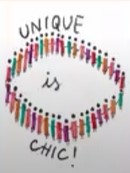Introduction
Every participant said 3 things about him/her; Then, leaders presented in 5-10 minutes their organization and local communities they are working in. Then the participants presented themselves again, using the «personal shield“: they had a big flipchart paper and a few coloured pencils. They draw a shield with 4 sectors. In each sector participants mentioned three main thinks related to: their past, their present, images of the distant future and desired goals for the immediate future. They were free to make any graphic representation (written words, drawings, paintings etc.) Then they discussed about what they draw in the papers.

From where I stand
A survey has been handed out and the young participants stated whether members of their community (eg. Prime Minister, doctor, favourite band member, teacher etc.) are female or male. After this short starting activity, questions have been asked to the groups in order to share and compare answers, getting to know the other people’s experiences in their own countries. It will encourage conversations between the different cultures and start the week off with open, understanding dialogue.

Gymkhana trough Madrid
Gender equality took again take the main role: through different clues the groups had to advance to the final clue. These clues listed different squares, monuments in Retiro Park (which will mainly included the memorialisation of male historical figures). The participants took photos and have been helped along their way by members of the local community. At the end they found a member of the Mad For Europe team to validate their participation and won a prize.

Fears and Expectations
Each participant receive post-its (yellow and blue) and they will write their expectations on the yellow post-its and their fears on the blue ones (as many as they want). They will stick them on two different walls in the meeting room. We will check daily if their expectations were met and their fears were avoided. On the last day, we will see all these papers and talk about them.
Photographing Madrid
In this activity, participants have again be splitted into groups and explored the streets of Madrid, observing everyday inequality and sexism. When they found an example of it, they took a photo of it and presented it later back at the hostel. Examples of these photos have been in advertising, statues, street names etc. Creativity has been encouraged as long as they could justify their reasons in the presentation.

Outlines
The participants have been provided with large sheets of paper and outlined a group member. Cards have be handed out and the groups used words
to describe a “real man” or a “real woman” and place on the different outlines (these could be in the participants’ first language to be translated too). Afterwards the students discussed these words/phrases in order to break these stereotypes and see how harmful they are in real-world settings.

Race to the Top
It has been a large-scale board game. The groups have be divided and given the role of male/female. The board game had biases written in for both ‘teams’ and set the ‘female’ group back significantly over the course of the game, making it easier for the male team to win. This has been again be followed by debate and discussion.

Collage and create
This activity helped participants to analise the media’s role within the entrenchment of gender norms and roles. They created a collage from tabloid magazines or headlines which exaggerate gender roles. This included also how both women and men’s lives are affected by these rhetorics

Creating a Logo
With the help of different materials (newspapers, magazines, paintings, etc), participants have been divided into teams and had to create a logo and a slogan for the project. They had to create it to be very eye-catching for its subsequent dissemination both in Madrid and in the rest of the regions of the partner countries. There has been a logo winner who became the official one of the project.

Testimonies
This activity has been run throughout the week and encouraged the participants’ creativity and public speaking skills. The groups have been split in terms of nationality and researched about a key female figure in their country this isn’t memorialised enough in their country. They presented their ideas for a state and have been encouraged to write a letter to their relevant local government member to campaign to implement it.

Closing of the project: Final Evaluation and Certificate Ceremony
To the participants had been given the certificates of the project, to certify their participation, and then they have been able to evaluate the project, expressing the positive and the negative things about it.
